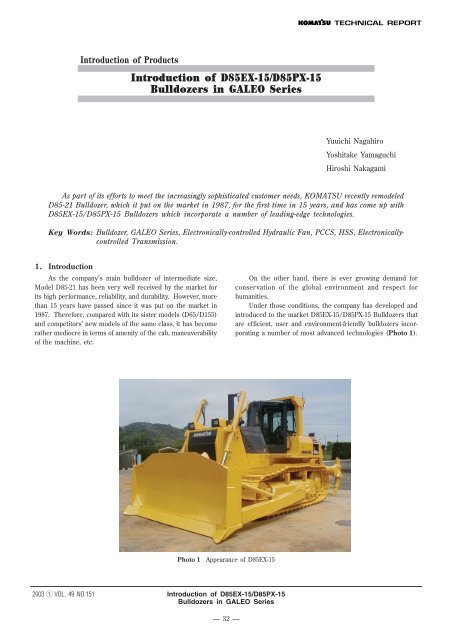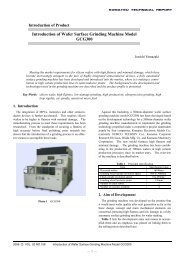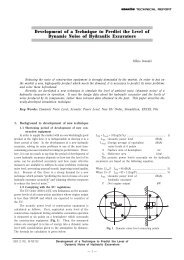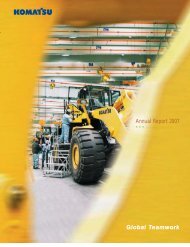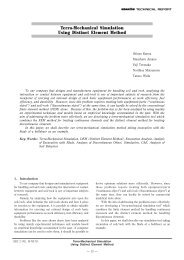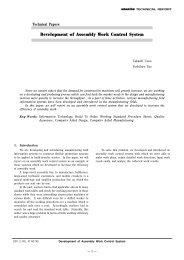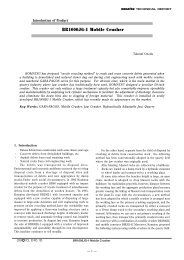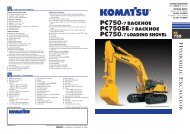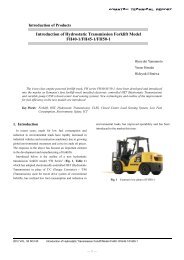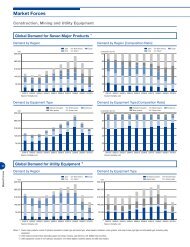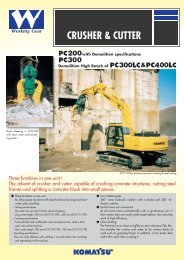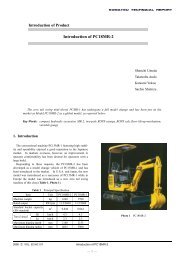Introduction of D85EX-15/D85PX-15 Bulldozers in ... - Komatsu
Introduction of D85EX-15/D85PX-15 Bulldozers in ... - Komatsu
Introduction of D85EX-15/D85PX-15 Bulldozers in ... - Komatsu
You also want an ePaper? Increase the reach of your titles
YUMPU automatically turns print PDFs into web optimized ePapers that Google loves.
2003 q VOL. 49 NO.<strong>15</strong>1<br />
<strong>Introduction</strong> <strong>of</strong> Products<br />
<strong>Introduction</strong> <strong>of</strong> <strong>D85EX</strong>-<strong>15</strong>/<strong>D85PX</strong>-<strong>15</strong><br />
<strong>Bulldozers</strong> <strong>in</strong> GALEO Series<br />
— 32 —<br />
Yuuichi Nagahiro<br />
Yoshitake Yamaguchi<br />
Hiroshi Nakagami<br />
As part <strong>of</strong> its efforts to meet the <strong>in</strong>creas<strong>in</strong>gly sophisticated customer needs, KOMATSU recently remodeled<br />
D85-21 Bulldozer, which it put on the market <strong>in</strong> 1987, for the first time <strong>in</strong> <strong>15</strong> years, and has come up with<br />
<strong>D85EX</strong>-<strong>15</strong>/<strong>D85PX</strong>-<strong>15</strong> <strong>Bulldozers</strong> which <strong>in</strong>corporate a number <strong>of</strong> lead<strong>in</strong>g-edge technologies.<br />
Key Words: Bulldozer, GALEO Series, Electronically-controlled Hydraulic Fan, PCCS, HSS, Electronicallycontrolled<br />
Transmission.<br />
1. <strong>Introduction</strong><br />
As the company’s ma<strong>in</strong> bulldozer <strong>of</strong> <strong>in</strong>termediate size,<br />
Model D85-21 has been very well received by the market for<br />
its high performance, reliability, and durability. However, more<br />
than <strong>15</strong> years have passed s<strong>in</strong>ce it was put on the market <strong>in</strong><br />
1987. Therefore, compared with its sister models (D65/D<strong>15</strong>5)<br />
and competitors’ new models <strong>of</strong> the same class, it has become<br />
rather mediocre <strong>in</strong> terms <strong>of</strong> amenity <strong>of</strong> the cab, maneuverability<br />
<strong>of</strong> the mach<strong>in</strong>e, etc.<br />
<strong>Introduction</strong> <strong>of</strong> <strong>D85EX</strong>-<strong>15</strong>/<strong>D85PX</strong>-<strong>15</strong><br />
<strong>Bulldozers</strong> <strong>in</strong> GALEO Series<br />
Photo 1 Appearance <strong>of</strong> <strong>D85EX</strong>-<strong>15</strong><br />
On the other hand, there is ever grow<strong>in</strong>g demand for<br />
conservation <strong>of</strong> the global environment and respect for<br />
humanities.<br />
Under those conditions, the company has developed and<br />
<strong>in</strong>troduced to the market <strong>D85EX</strong>-<strong>15</strong>/<strong>D85PX</strong>-<strong>15</strong> <strong>Bulldozers</strong> that<br />
are efficient, user and environment-friendly bulldozers <strong>in</strong>corporat<strong>in</strong>g<br />
a number <strong>of</strong> most advanced technologies (Photo 1).
2. Objectives <strong>of</strong> development<br />
With “friendl<strong>in</strong>ess to the user and environment” and “high<br />
levels <strong>of</strong> basic performance and quality” as the fundamental<br />
concepts and with the aim <strong>of</strong> giv<strong>in</strong>g complete satisfaction to all<br />
our customers <strong>in</strong> the world, we developed the new bulldozers<br />
with the follow<strong>in</strong>g po<strong>in</strong>ts as the primary objectives:<br />
(1) Reduc<strong>in</strong>g impact on the environment<br />
(2) Improv<strong>in</strong>g amenity <strong>of</strong> the cab and maneuverability <strong>of</strong> the<br />
mach<strong>in</strong>e<br />
(3) Enhanc<strong>in</strong>g work efficiency<br />
(4) Improv<strong>in</strong>g serviceability and reliability <strong>of</strong> the mach<strong>in</strong>e.<br />
In particular, special emphasis was placed on reduc<strong>in</strong>g<br />
mach<strong>in</strong>e noise and improv<strong>in</strong>g cab amenity and mach<strong>in</strong>e<br />
maneuverability. By mak<strong>in</strong>g the most effective use <strong>of</strong> electronics<br />
and employ<strong>in</strong>g advanced new technologies, we could achieve<br />
remarkable improvements.<br />
3. Salient characteristics<br />
3.1 Consideration for the environment<br />
(1) Reduction <strong>of</strong> ambient noise<br />
By employ<strong>in</strong>g a new eng<strong>in</strong>e whose rated speed is 5% lower<br />
than that <strong>of</strong> the conventional eng<strong>in</strong>e, an electronically-controlled<br />
hydraulic fan, air suction ducts <strong>in</strong>stalled <strong>in</strong> the eng<strong>in</strong>e hood and<br />
side covers, etc., the ambient noise could be reduced significantly<br />
(10 dB lower as compared with the former model) (Table 1).<br />
2003 q VOL. 49 NO.<strong>15</strong>1<br />
Table 1 Comparison <strong>of</strong> ambient noise<br />
Ambient noise<br />
(measured at po<strong>in</strong>t <strong>15</strong> m away from mach<strong>in</strong>e)<br />
dB(A) 70<br />
<strong>D85EX</strong>-<strong>15</strong> D85A-21<br />
In order for the former model to clear the new EU Noise<br />
Regulations (2000/14/EC), it was necessary not only to <strong>in</strong>stall<br />
a sound-absorb<strong>in</strong>g blade <strong>in</strong> front <strong>of</strong> the radiator but also to<br />
reduce the cool<strong>in</strong>g fan rated speed and apply sound-absorb<strong>in</strong>g<br />
material to suitable parts <strong>of</strong> the eng<strong>in</strong>e compartment. The new<br />
model <strong>of</strong> standard specifications meets the requirements, even<br />
though it is without sound-absorb<strong>in</strong>g material (measured value<br />
110 dB vs. control 112 dB).<br />
(1-1) Electronically-controlled hydraulic fan system<br />
The electronically-controlled hydraulic fan system<br />
employed for the new model controls the fan speed accord<strong>in</strong>g<br />
to eng<strong>in</strong>e cool<strong>in</strong>g water temperature, hydraulic oil temperature,<br />
and power-tra<strong>in</strong> oil temperature, thereby reduc<strong>in</strong>g the fan speed<br />
and noise and the loss <strong>of</strong> eng<strong>in</strong>e power.<br />
In addition, the motor for driv<strong>in</strong>g the fan is equipped with<br />
the function <strong>of</strong> revers<strong>in</strong>g the direction <strong>of</strong> fan rotation so as to<br />
permit chang<strong>in</strong>g the direction <strong>of</strong> fan rotation easily at the touch<br />
<strong>of</strong> a switch near the operator’s seat. This facilitates clean<strong>in</strong>g<br />
the core <strong>of</strong> the fan.<br />
The scheme and effect <strong>of</strong> this system are shown <strong>in</strong> Fig. 1<br />
and Fig. 2.<br />
(1-2) Installation <strong>of</strong> air suction ducts<br />
By <strong>in</strong>stall<strong>in</strong>g air suction ducts <strong>in</strong> the eng<strong>in</strong>e hood and side<br />
covers, it became possible to improve the flow <strong>of</strong> cool<strong>in</strong>g air,<br />
<strong>in</strong>crease the amount <strong>of</strong> air suction (+5%), and lower the<br />
temperature <strong>of</strong> air let <strong>in</strong> (–3°C). This <strong>in</strong> turn made it possible<br />
80<br />
<strong>Introduction</strong> <strong>of</strong> <strong>D85EX</strong>-<strong>15</strong>/<strong>D85PX</strong>-<strong>15</strong><br />
<strong>Bulldozers</strong> <strong>in</strong> GALEO Series<br />
— 33 —<br />
to improve the heat balance, lower the fan speed, reduce the<br />
noise from the eng<strong>in</strong>e compartment, and hence reduce the<br />
ambient noise significantly (Fig. 3).<br />
(2) Conformance to the second phase <strong>of</strong> gaseous emission<br />
regulations<br />
Thanks to a newly-developed, electronically-controlled,<br />
common-rail fuel <strong>in</strong>jection eng<strong>in</strong>e, the new model meets the<br />
second phase <strong>of</strong> gaseous emission regulations <strong>of</strong> North<br />
America, Europe, and Japan.<br />
Motor<br />
Pump<br />
Radiator<br />
Eng<strong>in</strong>e<br />
Controller<br />
Water Temp.<br />
Oil Temp.<br />
Fig. 1 Electronically-controlled hydraulic fan system<br />
Fan speed (Cool<strong>in</strong>g water temperature: 100 °C)<br />
Reduction<br />
<strong>of</strong> noise<br />
(Example: Water temperature 85 °C)<br />
Fig. 2 Effect <strong>of</strong> hydraulic fan system<br />
Fan<br />
Radiator<br />
Air flow<br />
Air flow<br />
Fig. 3 Scheme <strong>of</strong> air suction ducts<br />
Eng<strong>in</strong>e speed
3.2 Improvement <strong>of</strong> cab amenity<br />
(1) Cab damper mount<br />
The long-stroke cab damper mount which is filled with<br />
silicone oil and provided with spr<strong>in</strong>g rubber has dramatically<br />
reduced the vibration dur<strong>in</strong>g ord<strong>in</strong>ary run and the shock dur<strong>in</strong>g<br />
<strong>of</strong>f-road run. This has not only improved the rid<strong>in</strong>g quality. It<br />
has also reduced the noise reach<strong>in</strong>g the ears <strong>of</strong> the operator by<br />
restra<strong>in</strong><strong>in</strong>g the sound propagation along solid objects (Fig. 4<br />
and Table 2).<br />
Rubber<br />
Silicon oil<br />
Boot<br />
Table 2 Comparison <strong>of</strong> operator’s seat vibration and noise<br />
Operator’s seat vibration<br />
(F2/R2 level ground)<br />
Noise at operator’s ears<br />
(measured level)<br />
Spr<strong>in</strong>g<br />
2003 q VOL. 49 NO.<strong>15</strong>1<br />
Fig. 4 Cab damper mount<br />
VL(dB) 88/94<br />
<strong>D85EX</strong>-<strong>15</strong> D85A-21<br />
99/100<br />
dB(A) 75 82<br />
(2) Newly-designed large cab<br />
The large cab adopted for the new model has a wide w<strong>in</strong>dow<br />
area, <strong>of</strong>fer<strong>in</strong>g good visibility. In addition, the seal <strong>of</strong> the slid<strong>in</strong>g<br />
w<strong>in</strong>dows and doors has been improved to make the cab much<br />
more airtight and prevent entry <strong>of</strong> dust and dirt <strong>in</strong>to the cab.<br />
Furthermore, a large-capacity air conditioner has been<br />
<strong>in</strong>stalled <strong>in</strong> the cab to afford a comfortable space for the<br />
operator (Fig. 5 and Table 3).<br />
Comparison <strong>of</strong> field <strong>of</strong> vision<br />
Front<br />
Rear<br />
<strong>D85EX</strong>-<strong>15</strong> D85A-21<br />
<strong>D85EX</strong>-<strong>15</strong> D85A-21<br />
Fig. 5 Comparison <strong>of</strong> field <strong>of</strong> vision<br />
<strong>Introduction</strong> <strong>of</strong> <strong>D85EX</strong>-<strong>15</strong>/<strong>D85PX</strong>-<strong>15</strong><br />
<strong>Bulldozers</strong> <strong>in</strong> GALEO Series<br />
— 34 —<br />
Table 3 Comparison <strong>of</strong> cab specifications<br />
Cab volume m3 <strong>D85EX</strong>-<strong>15</strong> D85A-21<br />
3.2<br />
3.<strong>15</strong><br />
Visible area ratio % 57 51<br />
Cool<strong>in</strong>g capacity<br />
Air conditioner<br />
Heat<strong>in</strong>g capacity<br />
kcal/h<br />
kcal/h<br />
4500<br />
5500<br />
3500<br />
4000<br />
Pressurization mmAq 10 2.0<br />
3.3 Improvement <strong>of</strong> Maneuverability<br />
(1) Adoption <strong>of</strong> palm command control system (PCCS)<br />
The new model employs a s<strong>in</strong>gle electronically-controlled<br />
palm command control lever which just fits the human hand<br />
and which can be manipulated with m<strong>in</strong>imum operator stra<strong>in</strong>.<br />
This is a product <strong>of</strong> human eng<strong>in</strong>eer<strong>in</strong>g.<br />
With this s<strong>in</strong>gle lever, the operator can perform all the<br />
mach<strong>in</strong>e operations – move forward/backward, change speed,<br />
turn right/left.<br />
The controller performs optimum control <strong>of</strong> the<br />
transmission valve and HSS motor accord<strong>in</strong>g to signals from<br />
the potentiometer (forward, reverse, turn) and switch (shift)<br />
built <strong>in</strong> the lever. Therefore, the operator can maneuver the<br />
mach<strong>in</strong>e easily and efficiently.<br />
The scheme <strong>of</strong> this system is shown <strong>in</strong> Fig. 6, Fig. 7, and<br />
Fig. 8.<br />
Auto shift-down<br />
switch<br />
Accelerator pedal<br />
Fuel control<br />
valve<br />
Eng<strong>in</strong>e<br />
Preset-mode<br />
switch<br />
Eng<strong>in</strong>e controller<br />
Various<br />
switches<br />
Fuel dial<br />
Monitor panel<br />
Eng<strong>in</strong>e<br />
speed<br />
Steer<strong>in</strong>g & transmission<br />
controller<br />
Fuel temperature<br />
Eng<strong>in</strong>e oil pressure<br />
Eng<strong>in</strong>e speed<br />
Water temperature<br />
Right turn N Left turn<br />
Forward<br />
PCCS lever<br />
Transmission<br />
control valves<br />
ECMV<br />
ECMV<br />
ECMV<br />
ECMV<br />
ECMV<br />
Electronically-controlled<br />
transmission<br />
Fig. 6 Scheme <strong>of</strong> PCCS<br />
N<br />
Reverse<br />
Built-<strong>in</strong> potentiometer<br />
Fig. 7 Structure <strong>of</strong> PCCS lever<br />
EPC<br />
Speed sensor at exit<br />
<strong>of</strong> transmission<br />
HSS<br />
Control<br />
valve<br />
Incl<strong>in</strong>ation angle<br />
sensor<br />
Brake pedal<br />
potentiometer
LEFT<br />
TURN<br />
Steer<strong>in</strong>g Action<br />
FORWARD<br />
NEUTRAL<br />
REVERSE<br />
The console to which the PCCS lever is <strong>in</strong>stalled can be<br />
shifted forward/backward by up to 90 mm (<strong>in</strong> n<strong>in</strong>e steps) and<br />
shifted up/down by up to 60 mm (cont<strong>in</strong>uous). This arrangement,<br />
together with the adjustable operator’s seat, permits an<br />
operator <strong>of</strong> any physical build to manipulate the PCCS lever<br />
easily and positively (Fig. 9).<br />
30 30<br />
N<br />
Vertical adjustment<br />
<strong>of</strong> console<br />
2003 q VOL. 49 NO.<strong>15</strong>1<br />
RIGHT<br />
TURN<br />
Top View<br />
Fig. 8 PCCS lever<br />
Armrest<br />
Shift Select<br />
button<br />
UP<br />
DOWN<br />
Steer<strong>in</strong>g<br />
and<br />
Shift Control<br />
Fuel Dial<br />
(Electronic Control)<br />
30 60<br />
N<br />
Horizontal adjustment <strong>of</strong> console<br />
Fig. 9 Adjustable range <strong>of</strong> PCCS console<br />
For the work equipment, pressure proportional control<br />
(PPC) which is capable <strong>of</strong> m<strong>in</strong>ute control is employed.<br />
(2) Adoption <strong>of</strong> hydrostatic steer<strong>in</strong>g system (HSS)<br />
The HSS consists <strong>of</strong> a steer<strong>in</strong>g pump, steer<strong>in</strong>g motor,<br />
steer<strong>in</strong>g planetary gear, and PCCS lever/controller/EPC valve<br />
which control them (Fig. 10).<br />
Controller<br />
Steer<strong>in</strong>g lever<br />
Valve<br />
Work equipment &<br />
steer<strong>in</strong>g pump<br />
Eng<strong>in</strong>e<br />
Transmission<br />
Torque<br />
converter<br />
Steer<strong>in</strong>g planetary gear<br />
Brake<br />
Brake<br />
Sprocket<br />
Sprocket (deceleration)<br />
Fig. 10 Scheme <strong>of</strong> HSS<br />
(acceleration)<br />
Steer<strong>in</strong>g<br />
motor<br />
The HSS uses the differential mechanism <strong>of</strong> the planetary<br />
gear to give the power for forward movement, from the<br />
transmission, and the power for turn<strong>in</strong>g, from the hydraulic<br />
motor, a difference <strong>in</strong> output rotation between right and left,<br />
and thereby turns the mach<strong>in</strong>e (Fig. 11 and Fig. 12).<br />
When turn<strong>in</strong>g the mach<strong>in</strong>e, the HSS always transmits the<br />
power to both the <strong>in</strong>ner and outer belts, rather than cuts out<br />
the power to the <strong>in</strong>ner belt. Therefore, the mach<strong>in</strong>e can turn<br />
smoothly and positively (Fig. 12).<br />
<strong>Introduction</strong> <strong>of</strong> <strong>D85EX</strong>-<strong>15</strong>/<strong>D85PX</strong>-<strong>15</strong><br />
<strong>Bulldozers</strong> <strong>in</strong> GALEO Series<br />
— 35 —<br />
: ªA<br />
: ªB<br />
: ªC<br />
1 5 12 16 20<br />
ª3 ª2 ª1 ª4 ª5 ª6<br />
ªA :Transmission power<br />
ªB : HSS motor power<br />
ªC : Comb<strong>in</strong>ed power<br />
Fig. 11 Flow <strong>of</strong> power dur<strong>in</strong>g left turn<br />
ENG.<br />
T/M<br />
HSS<br />
Fig. 12 Lever manipulation and power flow dur<strong>in</strong>g left turn<br />
Transmission<br />
oil pressure<br />
wClutch pressure for previous speed stage is ma<strong>in</strong>ta<strong>in</strong>ed.<br />
Former model<br />
27<br />
26<br />
ª1. Transmission output speed<br />
ª2. HSS motor deceleration speed<br />
ª3. Left horizontal axle output speed(ª1 – ª2)<br />
ª4. Transmission output speed<br />
ª5. HSS motor acceleration speed<br />
ª6. Right horizontal axle output speed(ª4 + ª5)<br />
qHydraulic wave form is varied as required.<br />
Former model<br />
23 22 21 13 25<br />
(3) Electronically-controlled transmission<br />
The transmission adopted for the new model is equipped<br />
with an electronically-controlled modulation valve which is<br />
capable <strong>of</strong> modulat<strong>in</strong>g the <strong>in</strong>dividual speed stages <strong>in</strong>dependently<br />
<strong>of</strong> one another.<br />
It varies the modulation accord<strong>in</strong>g to hydraulic stage,<br />
eng<strong>in</strong>e speed, load, etc., thereby allow<strong>in</strong>g for smooth clutch<br />
control subject to m<strong>in</strong>imum shock.<br />
q The hydraulic wave form is varied as required.<br />
w Before chang<strong>in</strong>g the speed, the clutch pressure for the<br />
present speed stage is ma<strong>in</strong>ta<strong>in</strong>ed until engagement <strong>of</strong> the<br />
clutch to prevent the time lag and torque loss (Fig. 13).<br />
Fig. 13 Control <strong>of</strong> transmission oil pressure<br />
28<br />
Time
In addition, the electronically-controlled transmission is<br />
equipped with the follow<strong>in</strong>g functions as standard to reduce<br />
the frequency <strong>of</strong> speed change and improve the work efficiency.<br />
q Speed stage presett<strong>in</strong>g function which permits previously<br />
sett<strong>in</strong>g a forward/reverse speed stage selected from<br />
among three candidates<br />
w Auto shift-down function which, when the mach<strong>in</strong>e speed<br />
comes down due to an <strong>in</strong>crease <strong>in</strong> load, automatically shifts<br />
down the gear to ensure that the mach<strong>in</strong>e always works<br />
at highest efficiency.<br />
3.4 Improvement <strong>of</strong> productivity<br />
Thanks to the 5% <strong>in</strong>crease <strong>in</strong> eng<strong>in</strong>e output (compared<br />
with the former model) and the <strong>in</strong>troduction <strong>of</strong> advanced new<br />
technologies (e.g., the electronically-controlled hydraulic fan),<br />
the new model has atta<strong>in</strong>ed higher productivity (8% <strong>in</strong> terms<br />
<strong>of</strong> hourly workload) and better fuel efficiency (5%) than the<br />
former model (Fig. 14).<br />
Hourly workload (m 3 /h) Fuel efficiency (m 3 /)<br />
1.08<br />
<strong>D85EX</strong>-<strong>15</strong> D85A-21 <strong>D85EX</strong>-<strong>15</strong> D85A-21<br />
Fig. 14 Comparison <strong>of</strong> doz<strong>in</strong>g workload<br />
2003 q VOL. 49 NO.<strong>15</strong>1<br />
1.0<br />
1.05<br />
3.5 Improvement <strong>of</strong> serviceability<br />
(1) Adoption <strong>of</strong> new monitor panel equipped with selfdiagnostic<br />
function<br />
When some trouble occurs with the mach<strong>in</strong>e, the new<br />
monitor panel displays the content <strong>of</strong> the trouble by the associated<br />
error code. It is also possible to have the monitor panel<br />
display the condition <strong>of</strong> ma<strong>in</strong>tenance <strong>of</strong> the mach<strong>in</strong>e (Fig. <strong>15</strong><br />
and Fig. 16).<br />
Monitor panel with<br />
self-diagnostic function<br />
Display (multi-<strong>in</strong>formation)<br />
Sequence <strong>of</strong> monitor display<br />
2-PM CLINIC<br />
MODE<br />
1.0<br />
Display (speed stage, eng<strong>in</strong>e speed)<br />
Fig. <strong>15</strong> New monitor panel<br />
1-OIL, FILTER<br />
MAINTENANCE MODE<br />
3-FAULT CODE<br />
DISPLAY MODE<br />
4-USER ADJUST<br />
MODE<br />
Fig. 16 Content <strong>of</strong> <strong>in</strong>formation<br />
Caution display<br />
<strong>Introduction</strong> <strong>of</strong> <strong>D85EX</strong>-<strong>15</strong>/<strong>D85PX</strong>-<strong>15</strong><br />
<strong>Bulldozers</strong> <strong>in</strong> GALEO Series<br />
— 36 —<br />
(2) Modularized design <strong>of</strong> power tra<strong>in</strong><br />
The modularization <strong>of</strong> the power tra<strong>in</strong> (closed units) has<br />
made it possible to perform clean work with m<strong>in</strong>imum oil leak<br />
and dramatically reduce the time and labor for disassembl<strong>in</strong>g/<br />
reassembl<strong>in</strong>g the <strong>in</strong>dividual units (about one-third that <strong>of</strong> the<br />
former model) (Fig. 17).<br />
Fig. 17 Modularized power tra<strong>in</strong><br />
(3) Prolonged time <strong>in</strong>tervals <strong>of</strong> change <strong>of</strong> eng<strong>in</strong>e oil filter<br />
element, hydraulic oil, and hydraulic oil filter element<br />
(twice that <strong>of</strong> the former model).<br />
(4) Adoption <strong>of</strong> a disc brake to reduce the ma<strong>in</strong>tenance burden<br />
(band brake was used <strong>in</strong> the former model).<br />
(5) Adoption <strong>of</strong> a hydraulic fan to elim<strong>in</strong>ate the need <strong>of</strong> belt<br />
<strong>in</strong>spection and to facilitate clean<strong>in</strong>g the radiator (because<br />
the direction <strong>of</strong> fan rotation can be reversed).<br />
Thus, the serviceability has been improved dramatically.<br />
3.6 Improvement <strong>of</strong> reliability<br />
(1) Improvement <strong>of</strong> reliability <strong>of</strong> undercarriage<br />
The wear resistance <strong>of</strong> undercarriage parts has been<br />
appreciably improved by <strong>in</strong>creas<strong>in</strong>g the l<strong>in</strong>k height, subject<strong>in</strong>g<br />
the materials to more effective heat treatment, and <strong>in</strong>creas<strong>in</strong>g<br />
allowance for wear (Fig. 18).<br />
L<strong>in</strong>k + track roller Carrier roller<br />
1.35<br />
1.0<br />
1.2<br />
1.0<br />
Bush<strong>in</strong>g Idler<br />
1.4<br />
1.0<br />
1.2<br />
1.0<br />
<strong>D85EX</strong>-<strong>15</strong> D85A-21 <strong>D85EX</strong>-<strong>15</strong> D85A-21 <strong>D85EX</strong>-<strong>15</strong> D85A-21 <strong>D85EX</strong>-<strong>15</strong> D85A-21<br />
Fig. 18 Comparison <strong>of</strong> undercarriage durability<br />
(2) Improvement <strong>of</strong> reliability <strong>of</strong> electrical parts<br />
For connection <strong>of</strong> the ma<strong>in</strong> harnesses, a highly reliable<br />
DT connector is used. In addition, the branches with<strong>in</strong><br />
harnesses have been subjected to pott<strong>in</strong>g treatment (cover<strong>in</strong>g<br />
with fork tube) to improve corrosion resistance and durability<br />
(Fig. 19).<br />
Solder bath<br />
Wire core<br />
Branch is soldered<br />
Seal<strong>in</strong>g material<br />
Branch is fixed<br />
to harness<br />
MAX.50<br />
Covered with heat-contraction<br />
tube with bond<br />
Fig. 19 Pott<strong>in</strong>g
(3) Separation <strong>of</strong> power tra<strong>in</strong> from frame<br />
A hull frame construction has been employed for the ma<strong>in</strong><br />
frame to permit separat<strong>in</strong>g rubber-mounted power tra<strong>in</strong> units<br />
from the frame, thereby prevent<strong>in</strong>g the power tra<strong>in</strong> from be<strong>in</strong>g<br />
<strong>in</strong>fluenced by external force and improv<strong>in</strong>g its reliability.<br />
(4) The blade tilt pip<strong>in</strong>g has been completely built <strong>in</strong> the blade.<br />
3.7 Improvement <strong>of</strong> transportability<br />
Based on a review <strong>of</strong> the mach<strong>in</strong>e-body construction, the<br />
mach<strong>in</strong>e height has been significantly reduced to clear the domestic<br />
transportation regulation on maximum mach<strong>in</strong>e height<br />
<strong>of</strong> 3,800 mm with the cab kept on (when transported by a trailer<br />
whose floor height is 600 mm) (Table 4 and Fig. 20).<br />
Cab height (H) 3,800 mm limit set by<br />
domestic transportation regulations<br />
2003 q VOL. 49 NO.<strong>15</strong>1<br />
Table 4 Comparison <strong>of</strong> cab height<br />
mm<br />
–<br />
Fig. 20 Cab height<br />
<strong>D85EX</strong>/PX-<strong>15</strong> D85A/P-21<br />
3163/3200<br />
With<strong>in</strong> limit<br />
3380/3420<br />
Beyond limit<br />
3.8 Reduction <strong>of</strong> Cost<br />
In the present development, the departments concerned<br />
(Development, Manufactur<strong>in</strong>g, and affiliated companies) made<br />
a concerted effort to rationalize the mach<strong>in</strong>e construction,<br />
reduce the number <strong>of</strong> parts, employ low-cost materials, and so<br />
on. As a result, the mach<strong>in</strong>e cost could be cut significantly<br />
(10% lower than the former model).<br />
Examples <strong>of</strong> cost-cutt<strong>in</strong>g measures taken with the ma<strong>in</strong><br />
frame are shown <strong>in</strong> Fig. 21.<br />
Mach<strong>in</strong><strong>in</strong>g after assembly was abolished.<br />
Rate <strong>of</strong> automatic weld<strong>in</strong>g was <strong>in</strong>creased.<br />
ROPS bracket were comb<strong>in</strong>ed <strong>in</strong> one unit.<br />
Low-cost materials were used.<br />
Solid radiator guard was adopted.<br />
H<br />
Coreless S-case cast<strong>in</strong>g was adopted.<br />
Fig. 21 Cost-cutt<strong>in</strong>g measures taken with ma<strong>in</strong> frame<br />
<strong>Introduction</strong> <strong>of</strong> <strong>D85EX</strong>-<strong>15</strong>/<strong>D85PX</strong>-<strong>15</strong><br />
<strong>Bulldozers</strong> <strong>in</strong> GALEO Series<br />
— 37 —<br />
4. Conclusion<br />
In the present development <strong>of</strong> the new model, we could<br />
improve the mach<strong>in</strong>e performance and quality by <strong>in</strong>troduc<strong>in</strong>g a<br />
number <strong>of</strong> most advanced technologies and cut the mach<strong>in</strong>e cost<br />
significantly (10% lower than the former model).<br />
As the company’s first product hold<strong>in</strong>g the unquestioned<br />
lead, the new model was put on a mass-production l<strong>in</strong>e <strong>in</strong> January<br />
2003. The reputation that the new model is a surpris<strong>in</strong>gly quiet,<br />
easy-to-operate mach<strong>in</strong>e is already becom<strong>in</strong>g widespread.<br />
<strong>Introduction</strong> <strong>of</strong> the writers<br />
Yuuichi Nagahiro<br />
Entered <strong>Komatsu</strong> <strong>in</strong> 1970. Currently<br />
work<strong>in</strong>g <strong>in</strong> Quality Assurance Department,<br />
Osaka Plant, Production Division, <strong>Komatsu</strong>.<br />
Yoshitake Yamaguchi<br />
Entered <strong>Komatsu</strong> <strong>in</strong> 1971. Currently<br />
work<strong>in</strong>g <strong>in</strong> Construction Equipment<br />
Technical Center 1, Development Division,<br />
<strong>Komatsu</strong>.<br />
Hiroshi Nakagami<br />
Entered <strong>Komatsu</strong> <strong>in</strong> 1973. Currently<br />
work<strong>in</strong>g <strong>in</strong> Construction Equipment<br />
Technical Center 1, Development Division,<br />
<strong>Komatsu</strong>.<br />
[A few words from the writers]<br />
Right from the start, we organized a project team to come up<br />
with a new model with development emphasis on cutt<strong>in</strong>g the cost<br />
drastically and improv<strong>in</strong>g the cab amenity dramatically (stick<strong>in</strong>g<br />
to gorgeousness).<br />
It was the first time for us to extensively apply 3D-CAD <strong>in</strong> the<br />
development <strong>of</strong> a bulldozer. We implemented various measures<br />
and made various improvements to efficiently carry out the entire<br />
process from development to mass production.<br />
And now, we could deliver to the world the new model as one<br />
which has atta<strong>in</strong>ed Q.C.D as planned.<br />
In the future, we <strong>in</strong>tend to strive to stabilize the quality and<br />
promote the sales <strong>of</strong> the new model.


